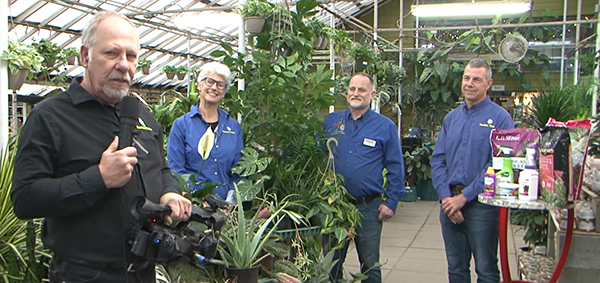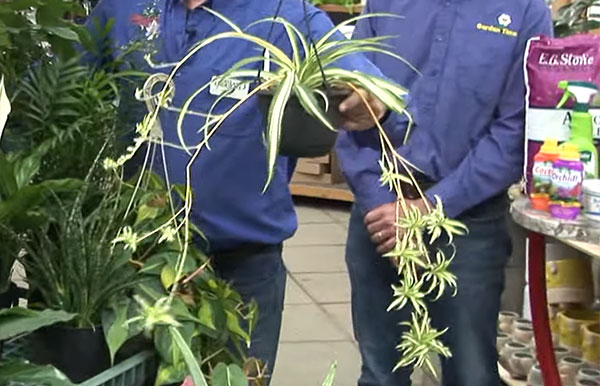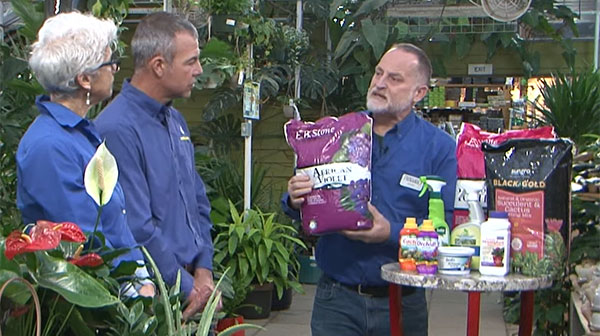|
Season 1 • Episode 11 - December 14, 2022

During the winter it is tough to keep
your green thumb from wilting from lack of activity.
However, all you may need is to get a few indoor plants.
Indoor plants are a ‘hot’ item the last few years with
people sometimes paying hundreds of dollars for new and
unique indoor plants, but you don’t have to be a plant
expert or break the bank to find some beautiful plants
to bring into your home.
To get an idea about some great starter plants for your
home or office we stopped by Portland Nursery, in
Portland, Oregon, and talked with George Bowman in their
huge greenhouse area. Portland Nursery on Division
Street has one of the biggest and best selections of
plants anywhere, and George pulled out a big assortment
of plants that would make any plant lover (beginner or
expert) happy.

George had easy plants and those that require a little
more attention, but he started with one of the easiest,
the spider plant (Chlorophytum comosum), this is a plant
for those who don’t know anything about plants. Not only
does it tolerate the extremes of conditions, but it will
also give you more plants to share with its tendrils
with new plants at the tips of each branch. Because of
these little flying plants, it is also called the
‘airplane plant’. It is great in hanging baskets so
those airplanes hang out and ‘fly’ around the plant. It
likes a medium light and a well-drained container.
We then moved to palms and one of the easiest is the
parlor palm. This one grows short and wide, getting to
about 4 feet tall and as wide as the well-drained pot
you put it in. It is the entry point to growing palms in
your home. The lady finger palm was next and it is also
an easy one to grow, but you need to keep this one moist
at all times. This one is seen in the lobbies of hotels
because it is so resilient and tough. It will just keep
on growing. The name is due to the lady like finger
fronds that keep on coming up from the base to a height
of 6 feet in your home, larger in larger spaces. Most
palms will not grow when you cut the tops down, but this
one keeps going because it sends up new canes from the
base, making it a perfect plant for the home gardener.
If you are looking for a larger indoor plant the Natal
Mahogany is the one for you. Though it can get over 40
feet tall in nature and in full sun. It can handle the
low light situations of the home much better than most
plants. It will respond well to pruning too. If you want
it to stay at 6 feet, you just prune it to 6 feet and it
will continue to thrive.
A lot of people want to have a nice hanging plant in
their home and the philodendrons will do well in a
hanging planter or pot. The heart shaped (leaves are
shaped like hearts) are perfect and beautiful, as
demonstrated by the variety ‘Brazil’ with its wonderful
variegated leaves. This is one of the easiest plants to
grow indoors. It is a vine so you can train the vines to
grow up supports or you can trim them off and it will do
well. It is easy care for watering too, just look for
when it just starts to wilt and then water it well and
let it drain, and wait for it to wilt again. There are a
lot of different varieties so you can easily find one to
fit your style or décor. If you are looking for
something a little bigger, but as easy to care for, then
the spilt leaf philodendron is for you. It is called
monstera deliciosa, because it can be as big as a
monster! These can get huge with leaves that match the
epic size of this plant. They have a wonderful ‘split’
leaf, but when you get them as a small plant the leaves
are solid with no pattern or splits at all. When the
plant gets bigger the leaves get their distinctive
splits. As the leaf gets larger it can also get some
‘Swiss cheese’ holes as well, giving it the other name
it is known by the ‘Swiss Cheese Plant’. If it starts to
get too big just cut it back and it will rebranch and
become fuller. The regular plant is pretty affordable,
but if you have a few extra dollars you can buy the rare
and variegated ‘Thai Constellation’. It can get big too,
but for this tiny one in a pot it was in the hundreds of
dollars. If you want to see how big they can get you can
stop by the Division Street store and see one on the
wall that is 2 stories tall and over 20 years old.
While we were talking about big plants it brought up a
point about knowing your conditions. Know your space,
the amount of light the plant needs, temperatures and
the amount of watering the plant may need. One other
point is how much work are you willing to dedicate to
taking care of your plants? Answering these questions
will go a long way to being successful with your indoor
plants. It is just like an outdoor plant; right plant,
right place. Of course, George also told us that you can
treat the plants as a short term plant to fill a spot.
You can buy a cheaper plant to fill a space and then
replace it with another one if the original plant gets
too tall or wide.
We then found a few more hanging types of plants. George
brought out a couple of Hoya plants. There was a heart
leaf shaped hoya that was known as a ‘Sweetheart’ hoya
with large leaves, and a smaller variegated leafed hoya.
They like good, even light and an even moisture too. The
beautiful part of the hoya are the flowers which George
calls a shooting star in an upside down parasol. They
have a wonderful fragrance than will take you by
surprise.

Next we jumped to snake plants. These are some of the
toughest plants and a great one for any beginner. They
thrive as long as you leave them in a tight pot and
don’t over water them. They generally have leaves that
are very pointy, which may give them their other common
name ‘mother-in-law’s tongue’. The common variety has
wider leaves and are known as ‘whale tails’, and the
other specialty types are thinner and have more
variegation. They are very slow growing and can handle
very low light conditions. In fact, this is a favorite
for people who like to have plants in their offices
where there is low fluorescent light. They will also
tell you when to repot the plant, by breaking out of
their pot! These are strong plants and will even break
clay pots! Because of this you want to make sure that
you get a pot that has straight sides and not curved
inward. This will make repotting a lot easier. Chinese
Evergreen (Aglaonema) was next and it looked like a
small broad leafed bush in a pot. It also likes low
light conditions and a tight pot. This brought up
another point. When you take a plant home or move it
around your home and it encounters different lighting
conditions, you could notice some leaf drop. The plant
may look like it is dying, this is normal and something
you can expect for a lot of different plants. We’ve
noticed it on house plants and also plants like citrus
plants when we move them back inside after the summer on
our deck. This can also happen right after you repot
your plants too. On the Chinese Evergreen, you could
lose up to 50 percent of the leaves, but the plant will
survive.
While we took a break George went and picked up a couple
other Chinese Evergreens to look at. These had a huge
difference in leaf and stem color. It really showed the
differences in variegation and styles you can choose
from.
We moved, next, to some flowering houseplants. We
started with the anthurium. A lot of people know this
one because of the large waxy blooms that it gets. Most
of the time these heart shaped blooms also have a large,
bright, spadix (oura or tail) coming out of the center
of the bloom. They like to be well watered but not over
watered. Over watering can happen from over attentive
gardeners, or because the pot doesn’t have good
drainage. Be careful to make sure your plant is not
sitting in water for long periods of time. Even if a
plant likes wet conditions you should be sure that you
aren’t loving your plant to death by giving it too much
water. Anthuriums come in a bunch of colors like white,
pink and red. Another bloomer is the Peace Lily (Spathiphyllum).
It too has a large bloom with a spadix in the center.
The bloom resembles a cobra’s head. This one likes a
moist soil, regular fertilization, and can handle low
light conditions and still bloom. George told us that it
can be easy to forget to water this one and once it goes
dry it will need a good soaking to rebound. To help the
plant, once it is watered, lay it on its side for a
short time, this way the plant doesn’t have to fight
gravity to get the water back up to the leaves. Another
blooming plant is the Prayer Plant (Maranta leuconeura).
Though the blooms on this one are small, the incredible
foliage more than makes up for that. Highly variegated
and full of color and a striking pattern. These are a
great plant all year round. It is known as the prayer
plant because at night the leaves fold up. It also
prefers low light and even watering.
We had a side discussion about temperatures. Since most
of these are tropical plants you will want to maintain a
minimum temperature of 65 degrees. If you like your
furnace to kick down to a cooler temperature late at
night, your indoor plants may not like that. Always
check with your garden center on the extremes of
temperature your plants can handle.
Looking at plants that can survive with little or no
water and light, we turned to the ZZ plant. The rumor is
that you only have to water it 4 times a year, it is
that easy to take care of. It is also said that you can
put it in a closet and it will survive, though we don’t
recommend that! The Aloe was also on the table and it
too can survive on a little water, though it will need
regular water, just not every week. A lot of people will
wait for the fleshy leaves to just start to shrivel and
then they will soak their plant well and let it drain,
then it is good for another few months or so. This was
the medicinal Aloe. So if you get a burn or scrape, you
can snap off a leave and rub it on your skin to help
with healing. The final plants we looked at were the air
plants (tillandsia). These are epiphytes, so they don’t
need soil and in nature they grow on other plants,
usually tree trunks and branches. Because they don’t
need soil you can put them anywhere, even hanging them
on a string hanging from your ceiling. For care, you
will want to soak them in water about once a week, or
give them a good misting a couple times a week. Some
people find that a moist part of the house, like a
bathroom, are good at keeping them watered and healthy.
Once watered, let them dry and put them back on display,
preferably in an area with medium light. If you are
lucky and keep them happy they will bloom for you with
wonderful, colorful, little blooms.
Overall, when you have indoor plants you will want to
know their watering needs. For most that may include
having them thoroughly watered, but well drained
conditions. Light is very important for most of these
plants and if you want to have plants that require lots
of light you can try artificial lighting to help them
thrive.

Finally, we moved over to products to help your indoor
plants. We started with soils. As George said, ‘healthy
roots, happy plant’. That means getting the right soil
for the plants you are growing. Don’t use ‘dirt’ from
your garden, this may be introducing pests and diseases
to your plants (and into your home). You will want to
use a soil that is formulated for your plants. Cactus,
African Violets and Succulents all have specific needs
and there are special soils for them and other indoor
plants.
Then we talked about plant food and fertilization.
Remember, you like to eat, so do your plants. Since
these are tropical plants with special needs, they might
also need special plant foods to keep them growing.
Always check with your garden center to make sure you
have the right food for the right plant.
Then we talked about pests. For a quick solution to a
bug problem, you can use a synthetic approach. We saw a
granular product from Bonide, the Systemic Houseplant
Insect Control. This product is sprinkled around the
base of the plant and is taken up through the ‘system’
of the plant. This takes care of those critters in the
roots and the leaves. Another product you can use is the
‘Eight Insect Control’. This is a foliar application so
you spray it on the leaves to knock down those nasty
bugs.
For the natural products you could use the Bonide
Insecticidal Soap spray. This is a natural product that
will smother the eggs and young insects. If you have a
problem with mites, you might want to use the Bonide
Mite-X product. There was one last natural product from
Bonide called Bon-Neem. This product is a double hit to
bugs. The first effect is a quick knock-down action for
the bugs and then the sulfur in the product will help
control fungus and mites.
Of course the difference between the natural product and
the chemical product is the times for application.
Natural and Organic products have to be applied more
often than synthetic and chemical products. Natural and
organic products tend to break down quicker in nature
than the others.
Always remember that the label is the law! Always follow
the label instructions for proper use and don’t use a
product for a problem that isn’t listed on the label.
For a Bonide retailer near you, you can always go the
Bonide website. We also recommend that you call first so
you can be sure they have the product you need before
you show up.
We also can recommend an occasional cleaning. You can
mist them with water and wipe them down, or you can use
a ‘leaf shine’ product on the larger leafed plants to
knock off the dust and dirt. While you are doing that,
check for bugs or diseases. If you notice something you
may want to check with your local garden center to
narrow down what you find.
We ended by talking about plants and pets. George talked
about toxicity. Just because a plant is labeled as
toxic, doesn’t mean it will be a danger to your pets (or
children). Toxicity can mean that an animal can react in
a negative way to a plant. For example, poinsettias are
toxic, but it would take an animal consuming a very
large amount of leaves to have an extreme reaction. Most
likely your animal will vomit long before it would eat
enough to die. Still, you will want to be careful and
know your plants beforehand. The ASPCA (American Society
for the Prevention of Cruelty to Animals) has a great
list of indoor plants and their toxicity on their
website, that you can check out before you buy.

We hope this episode helps you keep your green thumb in
shape during the winter and into the new year.

PODCASTS
2022
• Return to Current Year Podcast List
 |